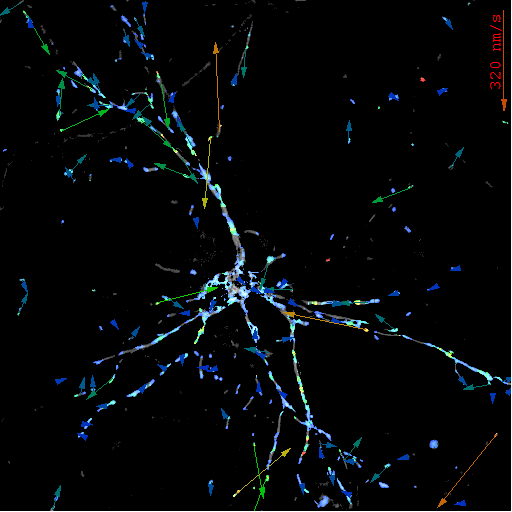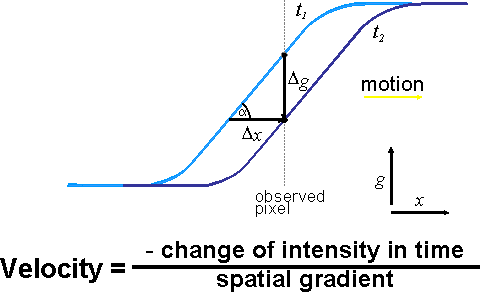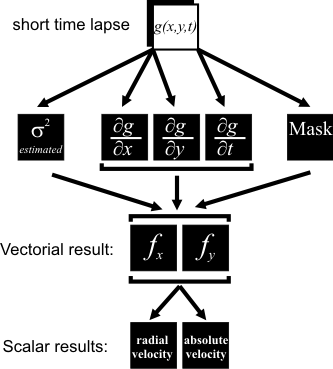 |
 |
| Left: A rat hippocampal neuron expressing mitochondrially
targeted GFP (gray outline) was imaged by wide-field
microscopy, building an x,y,t,t Multi-Dimensionaldata
set in Metamorph. x,y,t,t stands for a time lapse
of short time apses. Each short time lapse was processed
by Image Analyst MKII resulting an Optical Flow image (pseudocolor
overlay). These short time lapses comprised only two
frames separated by a one sec interval. The above movie,
to show actual velocity vectors, was composed in
Mathematica 5.2 from the x and y vector component
and the RGB images calculated by the Image Analyst MKII.
Right: A short time lapse of 2 frames, a smaller region of the original 512x512 pixels image is shown. Images are the same recording as on the left side. |
|
Calculation of Optical Flow
Optical Flow is calculated from 'short time lapses' of fluorescence micrographs. The short time lapse in practice means two or more images that were recorded with a short acquisition interval. The short time lapse is optimally two images; two images are sufficient to determine subpixel dislocations of edges of object in the image. Then, a time lapse of Optical Flow (velocity) images can be generated from a time lapse of short time lapses. The 'short time lapse' expression is used to make distinction from the overall time lapse of the the experiment,which comprises of cyclically repeated short time lapses.
Velocities are calculated from the spatial and temporal derivatives of the short time lapse:
 |
 |
| The discrete least squares method of Optical Flow calculation2
was reworked for fluorescence microscopy by taking low light level
photon shot noise (Poisson noise) in account1: Left: The cross section of the edge of an object is shown (blue). g is gray value intensity, x is a spatial coordinate. The object moves to the right. The object was in the light blue position in t1 time point and gets to the dark blue position at t2. Optical flow is calculated over the observed pixel, where the edge of an object passes by. The ratio of the change of the intensity of the observed pixel and the spatial gradient (the steepness of the blue line) gives the velocity. Therefore, when dealing with images, Optical Flow is calculated from the temporally differentiated image sequence (this is the change of intensity in time) and from the spatially differentiated frames (that gives the steepness of the edges). Right: Simplified scheme of Optical Flow calculation (for details see Gerencser and Nicholls 2008 Figure 7.). A short time lapse (g(x,y,t) referring to gray value intensities according to x,y,t coordinates) is processed by noise estimation (based on known noise characteristics of the camera or detector), by spatial and temporal differentiation, and by binarization. The primary result of the Optical Flow algorithm is a pair of images of the x and y vector components of velocities. Then, absolute velocity, or radial velocity as compared to a point ROI is calculated. |
|
Masking of Optical Flow images
Optical Flow can be unambiguously calculated only where objects have corners, tips, or bent edges. E.g. the motion of a straight, rod shaped object can be determined only at the tips, because it's middle points do not change intensity when it moves along its axis. The Optical Flow algorithm implemented in the Image Analyst MKII masks the images to allow readout of velocities only over those pixels where optical flow can be unambiguously determined.
Image Acquisition paradigms for Optical Flow
The image acquisition requirement of Optical Flow is:
In the Image Analyst MKII a time lapse recording of a single
fluorescence channel (recorded either continuously or in block
mode), thus the content of an Image Window can be transformed into
an Optical Flow (velocity) time lapse (panels A and B below). For
this use the Special/![]() Optical
Flow function.
Optical
Flow function.
Short time lapses recorded as part of a Multi-Dimensionalacquisition experiment are transformed into an Optical Flow (velocity) time lapse during loading of the selected channel and stage position (panel C, below). This is performed in the Multi-Dimensional Open dialog.
See also detailed protocols for Optical Flow measurement...